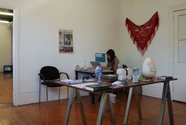John Hurrell – 29 October, 2009
Her attention is focused not so much on the objects changing hands and their matching worth, but the flicking on of stories. Of course I’m saying here these two things are separable, and maybe that can be disputed.
Auckland
Szu Han Chen
The room is too small to store memory
20 October - 6 November 2009
Szu Han Chen is an artist in residence from Taiwan who has studied at St. Martins College of Art and Design in London and at Cheng Chi University in Taipei. Her interactive and relational projects often incorporate videoed documentation of the various social exchanges or interpersonal negotiations she sets up. That aspect (of two earlier works) dominates the large front room, with her current ongoing interactive project occurring in the smaller back space at Snowwhite.
Her three channel installation Make a Wish (2009) shows abandoned objects (that can serve as containers) placed in front of a fountain in Washington Square in New York and filled with water as a symbol of hope for the homeless. It is hoped passers-by will throw money in. That way the needy can help themselves from these improvised ‘wishing wells.’
In Then I said ‘Have a Nice Day’ (2009) the artist approaches various individuals handling out flyers on the very crowded streets of New York. Because the activity is filmed secretly from a hidden camera that is far away it is hard to see (or hear) precisely what it is she is up to when she chats to the distributor, takes their promotional flyer, makes an origami plane out of it, and hands it back. While she sees her activity as transforming a ‘purposeful thing’ to something economically ‘useless’ and also poetical or contemplative, they being busy are likely to be puzzled or exasperated. Though her manner is sweet and charming, her actions can be taken as peculiar or ‘oddball’ at best, or at its worst, a veiled form of insult. Her actions imply she is taking something ‘useless’ and adding value. However nobody ever gets offended. Just perplexed.
The ‘Room’ work that is continuing now until the end of next week refers to storage problems in its title, and how to recycle old memories for new. The artist’s role here is that of facilitator. She co-ordinates the exchanging of abandoned items and their contextual narratives, the details of which she records and passes on.
Szu Han Chen here serves as a conduit for snippets of information and history. Invariably she will be compared to local artist Eve Armstrong and her Trading Table performances but my impression is that Armstrong is more proactive in suggesting solutions for fair swaps. She will broker (I think) transactions so that equivalent balancing occurs between giver and receiver. She will insist on exchanges that she thinks are equal.
Chen on the other hand seems to be quite happy for the value to be lopsided. She doesn’t directly bring contributing parties together, nor does she refuse any offer. In fact economic or social depreciation (like say potlatch) might be more her point, along with a poetic sensibility. Her attention is focussed not so much on the objects changing hands and their matching worth, but the flicking on of stories. Of course I’m saying here these two things are separable, and maybe that can be disputed. You might argue the only value that these items have is the narrative that accompanies them from usage, but that that narrative cannot be pried apart from their (re)saleable value – it just gets reabsorbed.
So how do you assess this kind of work? It has of itself no detectable visual aesthetic, but maybe the conveyed anecdotes, the sequences of past ownership (and linked events) as imagined mental pictures replace that? However the quality of such stories seems to be not the point either, nor is it the quality of Chen’s channelling of information - which appears to be striving for invisibility anyway?
In the end you look at the treasures you brought home to put on your shelf or workbench, briefly think about what useless things you discarded to get them, and forget about the artist and exhibition to get on with your life. Just like that pot of homemade chutney you got from some school fair eight months ago that is sitting around half eaten in your fridge. It’s not going mouldy for it tastes good, but where did you get it, and who served you, on that autumnal Saturday morning? You are not sure.
(The above images show the artist in her show, chatting to Abby Woolcombe, a student of the Design School. Photography by Karen Crisp.)







 Advertising in this column
Advertising in this column Two Rooms presents a program of residencies and projects
Two Rooms presents a program of residencies and projects



This Discussion has 0 comments.
Comment
Participate
Register to Participate.
Sign in
Sign in to an existing account.